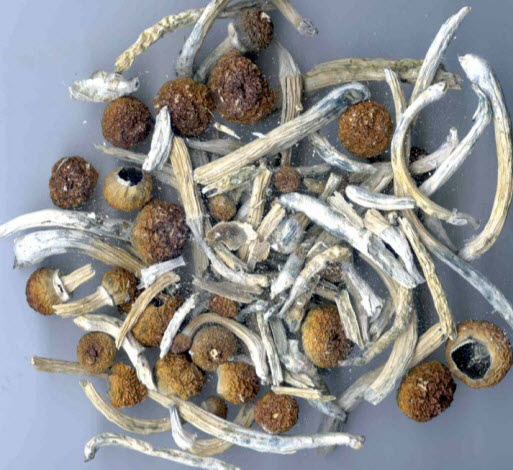Psilocybin
Psilocybin is a naturally occurring psychedelic compound produced by more than 200 species of fungi. Psilocybin is itself biologically inactive but is quickly converted by the body to psilocin, which has mind-altering effects including euphoria, visual and mental hallucinations, changes in perception, a distorted sense of time, and perceived spiritual experiences.
Natural occurrence
Psilocybin is present in varying concentrations in over 200 species of Basidiomycota mushrooms. The majority of these are found in Mexico, with the remainder distributed in the United States and Canada, Europe, Asia, Africa, and Australia and associated islands.
Both the caps and the stems contain psychoactive compounds, although the caps consistently contain more. The spores of these mushrooms do not contain psilocybin or psilocin.
History
Imagery in cave paintings and rock art of modern-day Algeria and Spain suggests that human use of psilocybin mushrooms predates recorded history.
In Mesoamerica, the mushrooms had long been consumed in spiritual and divinatory ceremonies before Spanish chroniclers first documented their use in the 16th century.
In 1958, the Swiss chemist Albert Hofmann isolated psilocybin and psilocin from the mushroom Psilocybe mexicana. His employer, Sandoz, marketed and sold pure psilocybin to physicians and clinicians worldwide for use in psychedelic therapy.
Research and restriction in use
In the early 1960s, Harvard University became a testing ground for psilocybin through the efforts of Timothy Leary and his associates. Leary obtained synthesized psilocybin from Hofmann through Sandoz Pharmaceuticals. In response to concerns about the increase in unauthorized use of psychedelic drugs by the general public, psilocybin and other hallucinogenic drugs were unfavorably covered in the press and faced increasingly restrictive laws. In the U.S., laws passed in 1966 that prohibited the production, trade, or ingestion of hallucinogenic drugs; Sandoz stopped producing LSD and psilocybin the same year.
In 1970, Congress passed "The Federal Comprehensive Drug Abuse Prevention and Control Act" that made LSD, peyote, psilocybin, and other hallucinogens illegal to use for any purpose, including scientific research. Despite the legal restrictions on psilocybin use, the 1970s witnessed the emergence of psilocybin as the "entheogen of choice."
Effects
After ingesting psilocybin, the user may experience a wide range of emotional effects which can include: feelings of disorientation, lethargy, giddiness, euphoria, joy, and depression. In one study, 31% of volunteers given a high dose reported feelings of significant fear and 17% experienced transient paranoia.
In studies at Johns Hopkins, among those given a moderate dose (but still enough to "give a high probability of a profound and beneficial experience"), negative experiences were rare, whereas one-third of those given a high dose experienced anxiety or paranoia.
Low doses can induce hallucinatory effects. Closed-eye hallucinations may occur, where the affected individual sees multicolored geometric shapes and vivid imaginative sequences. Some individuals report synesthesia, such as tactile sensations when viewing colors. At higher doses, psilocybin can lead to "intensification of affective responses, enhanced ability for introspection, regression to primitive and childlike thinking, and activation of vivid memory traces with pronounced emotional undertones." Open-eye visual hallucinations are common, and may be very detailed, although rarely confused with reality.
Users having a pleasant experience can feel a sense of connection to others, nature, and the universe.
Religious use
Psilocybin mushrooms have been and continue to be used in Indigenous American cultures and African diaspora religions in religious, divinatory, and spiritual contexts.
Reflecting the meaning of the word entheogen ("the god within"), the mushrooms are revered as powerful spiritual sacraments that provide access to sacred worlds. Typically used in small group community settings, they enhance group cohesion and reaffirm traditional values.
In general, psychedelic drugs can induce states of consciousness that have lasting personal meaning and spiritual significance in individuals who are religious or spiritually inclined; these states are called mystical experiences. Psilocybin mushroom usage is part of a cultural ethos relating to the Earth and mysteries of nature.
